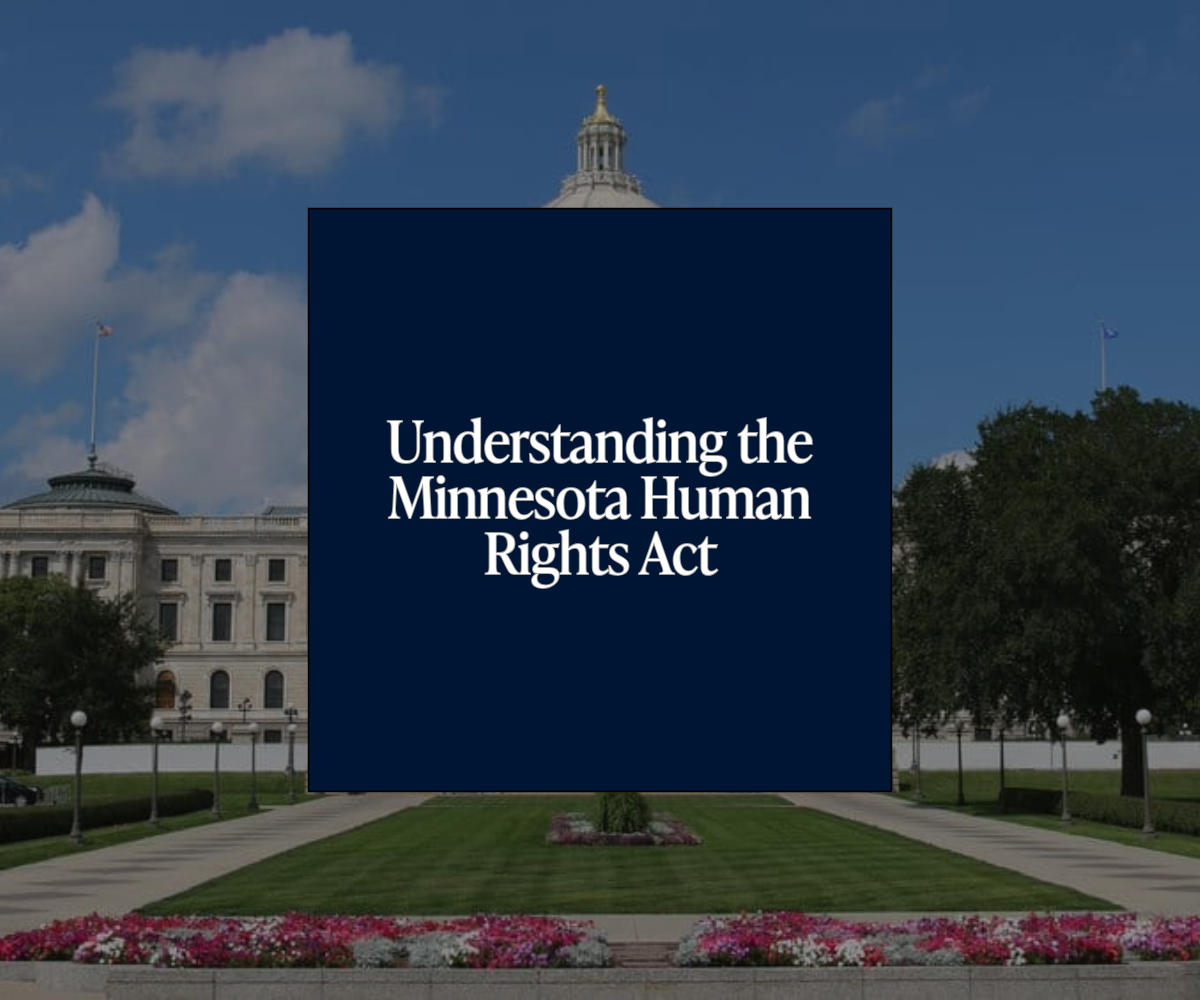The Minnesota Human Rights Act (MHRA) is a pivotal piece of legislation designed to protect the citizens of Minnesota from discrimination in various aspects of public life. Established to ensure equal opportunities and prevent discrimination on the basis of race, gender, disability, and other protected classes, the MHRA plays a crucial role in fostering an inclusive and fair environment across the state.
In this comprehensive guide, we will delve into the intricacies of the MHRA, discussing who it protects, the key provisions it includes, and how individuals can seek recourse if they believe their rights have been violated. Whether you are an employee, employer, or a resident of Minnesota, understanding the MHRA is essential for recognizing and upholding your civil rights under state law.
What is the Minnesota Human Rights Act?
The Minnesota Human Rights Act is a state law that prohibits discrimination in areas such as employment, housing, public accommodations, and education, among others. Enacted to complement federal anti-discrimination laws, the MHRA provides broad protections that often exceed those offered at the national level. It is enforced by the Minnesota Department of Human Rights, which investigates complaints and works to resolve issues of discrimination throughout the state.
In the following sections, we will explore the specific protections offered by the MHRA, how these apply to various sectors, and the procedures involved in filing a complaint and seeking justice under this important law.
Who is Protected Under the Minnesota Human Rights Act?
The Minnesota Human Rights Act offers protection against discrimination for various protected classes. It aims to safeguard individuals from unfair treatment based on specific characteristics that historically have been the basis for discrimination. Here are the protected classes under the MHRA:
- Race
- Color
- Creed
- Religion
- National Origin
- Sex, including pregnancy and sexual orientation
- Marital Status
- Disability
- Public Assistance Status
- Age
- Familial Status (in housing)
These categories ensure that individuals do not face discrimination in employment, housing, education, or public services based on these attributes. For example, it is unlawful for employers to make hiring or firing decisions based on an employee’s race or for a landlord to refuse renting to someone because of their familial status.
Key Provisions of the Minnesota Human Rights Act
Employment Discrimination
The MHRA makes it illegal for employers to discriminate in hiring, promotion, or termination processes based on any of the protected classes. This includes not only direct actions like refusing to hire someone because of their gender but also policies that may disproportionately affect one group without a justifiable reason. Employers are also required to make reasonable accommodations for employees with disabilities and to ensure that their workplaces are free from discriminatory practices.
Housing Discrimination
Under the MHRA, individuals are protected from discrimination in renting, selling, or obtaining financing for housing. It is illegal, for example, for a housing provider to deny an application based on an applicant's religion or to charge a higher security deposit specifically because of someone's national origin.
Public Accommodations
The act ensures that all persons have equal access to public services and accommodations, which include hotels, restaurants, theaters, and retail stores. Discrimination based on any protected characteristic in these settings is prohibited, ensuring that everyone can participate fully in public life.
Education Discrimination
Educational institutions are also covered under the MHRA. This protection ensures that students are not denied admission, nor treated differently in terms of grades or disciplinary actions, based on their protected class status. It also mandates that educational facilities address and prevent harassment based on these protected categories.
Filing a Complaint Under the Minnesota Human Rights Act
Process and Timeframe
If you believe you have been a victim of discrimination under the MHRA, you have the right to file a complaint with the Minnesota Department of Human Rights (MDHR). The process is designed to be accessible to ensure that everyone can seek justice. Here’s a step-by-step guide on how to file a discrimination complaint:
- Identify the Discrimination: Determine which protected class applies to your situation.
- Gather Documentation: Collect any relevant documents, emails, witness statements, or other evidence that supports your claim.
- File the Complaint: Complaints can be filed online, by mail, or in person at the MDHR. The complaint must be filed within one year of the alleged discrimination.
- MDHR Review: Once received, the MDHR will review your complaint to determine if there is sufficient evidence to proceed.
- Investigation: If the complaint is accepted, an investigator will be assigned to your case to gather more information, interview witnesses, and review documents.
- Resolution: The investigation may result in a finding, mediation, or dismissal. If discrimination is found, remedies may include compensation for damages, changes in policies, or other measures to correct the discrimination.
What to Expect After Filing a Complaint
The investigation process can vary in length but generally takes several months to complete. Throughout this time, the MDHR will keep you informed about the status of your complaint. If your case is particularly complex, it may require additional time to ensure a thorough investigation. During this period, mediation might be offered as an alternative to resolve the dispute without a formal hearing.
Remedies and Enforcement under the MHRA
If a complaint of discrimination is substantiated, the Minnesota Department of Human Rights can impose various remedies to correct the injustice. These remedies may include:
- Back pay and compensation for lost benefits for employment discrimination cases.
- Damages for emotional distress caused by the discriminatory act.
- Changes in policies or practices to prevent future discrimination.
- Reinstatement to a job or other position if wrongful termination occurred.
The MDHR also has the authority to enforce these remedies through legal means if necessary, ensuring compliance and addressing systemic issues that might have allowed discrimination to occur.
Recent Changes and Updates to the MHRA
The Minnesota Human Rights Act is periodically updated to reflect evolving societal norms and legal standards. Recent amendments have focused on expanding protections and clarifying the responsibilities of employers and other entities under the law. Key updates have included:
- Expanded Disability Definitions: The MHRA aligns with the ADAAA by including conditions that are episodic or in remission, enhancing protections for non-permanent disabilities.
- Extended Familial Status Protections: The MHRA now protects employees caring for vulnerable adults, broadening the definition beyond those with minor children at home.
- Broadened Harassment Protections: The amendments extend harassment protections to include all protected classes, not just for cases of sexual harassment.
- Increased Compensation Potential: The law shifts the decision on damages from judges to juries, removing the cap of $25,000 on punitive damages and allowing for the tripling of emotional distress damages.
- Procedural Improvements: The amendments extend the timeframe for filing a lawsuit to 90 days after a discrimination charge is dismissed by the Minnesota Department of Human Rights, providing more time for legal recourse.
These changes aim to make the MHRA more comprehensive and responsive to the needs of Minnesota's diverse population. Staying informed about these updates is crucial for all Minnesota residents and especially for employers, who must ensure their policies and practices comply with the latest legal requirements.
Comparing MHRA with Federal Anti-Discrimination Laws
While the MHRA is comprehensive, it is also important to understand how it aligns with and differs from federal anti-discrimination laws, such as the Civil Rights Act, the Americans with Disabilities Act, and the Age Discrimination in Employment Act. Here are some key points of comparison:
- Broader scope of protection: The MHRA often provides broader protections than federal laws, especially in terms of protected classes and the types of discrimination covered.
- Lower thresholds for employer coverage: Unlike federal laws, which typically apply to employers with 15 or more employees, the MHRA applies to any employer with one or more employees, making it applicable to virtually all Minnesota employers.
- Additional areas of protection: The MHRA includes areas not covered by federal laws, such as credit and public services, providing a more extensive framework for combating discrimination.
Understanding both state and federal laws is essential for fully grasping the protections available to individuals and the obligations imposed on employers.
Common Questions About the Minnesota Human Rights Act
To further demystify the MHRA, here’s a look at some frequently asked questions:
- How does the MHRA interact with other state laws?
- The MHRA works in concert with other Minnesota laws to provide a comprehensive anti-discrimination framework. Where there are overlaps, the MHRA often provides the higher standard of protection.
- Can I file a complaint under the MHRA if I've already filed a federal complaint?
- Yes, individuals can file complaints under both state and federal systems, though it may be beneficial to consult with a legal professional to understand the strategic implications.
- What are the penalties for violating the MHRA?
- Penalties can include fines, compensatory and punitive damages, and corrective actions such as reinstatement or policy changes.
You can read more frequently asked questions about Minnesota employment law here.
Conclusion
The Minnesota Human Rights Act is a cornerstone of civil rights protection in Minnesota, providing broad and effective safeguards against discrimination. Whether you are an individual seeking justice or an employer aiming to comply with the law, understanding the MHRA is crucial. By fostering an inclusive environment, adhering to the law, and embracing its spirit, we can all contribute to a more equitable Minnesota.
If you believe you have experienced discrimination, or if you are an employer seeking guidance on compliance with the MHRA, consider reaching out to a knowledgeable attorney who specializes in civil rights and employment law.
For a complete list of employee rights and legal tools, visit our Employment Law Resources.
Request a Free Case Consultation
Employment Law Guidance in for Employees in Florida and Minnesota
Submit Your Case
